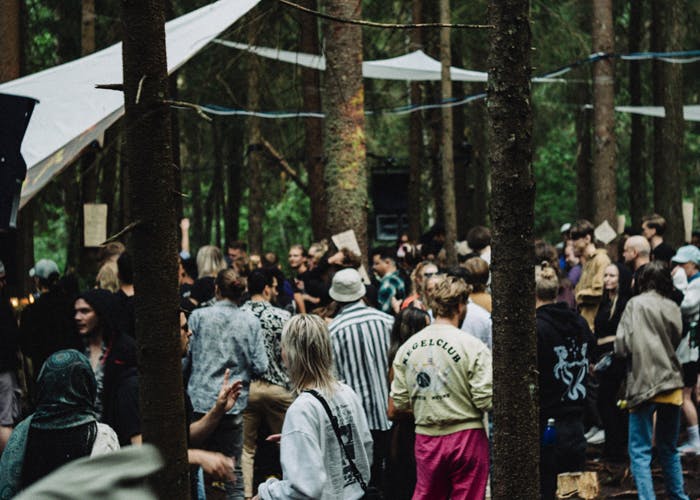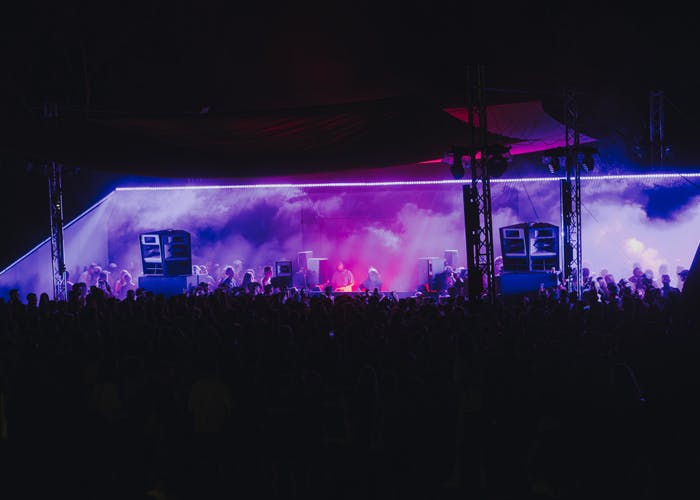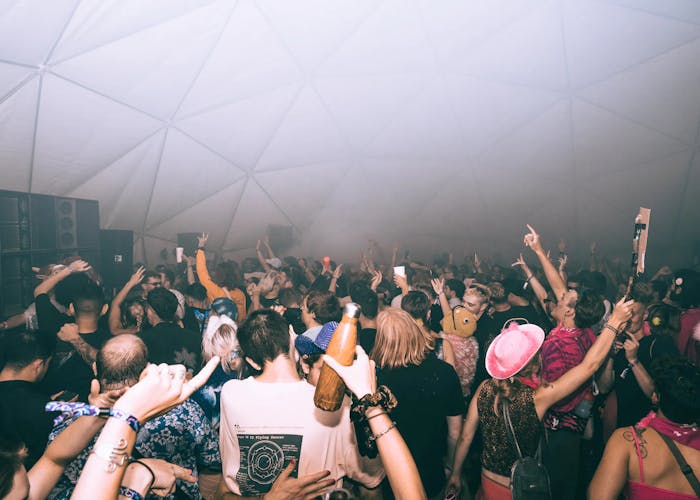
Constant State of Evaporation: Watching Trees 2024
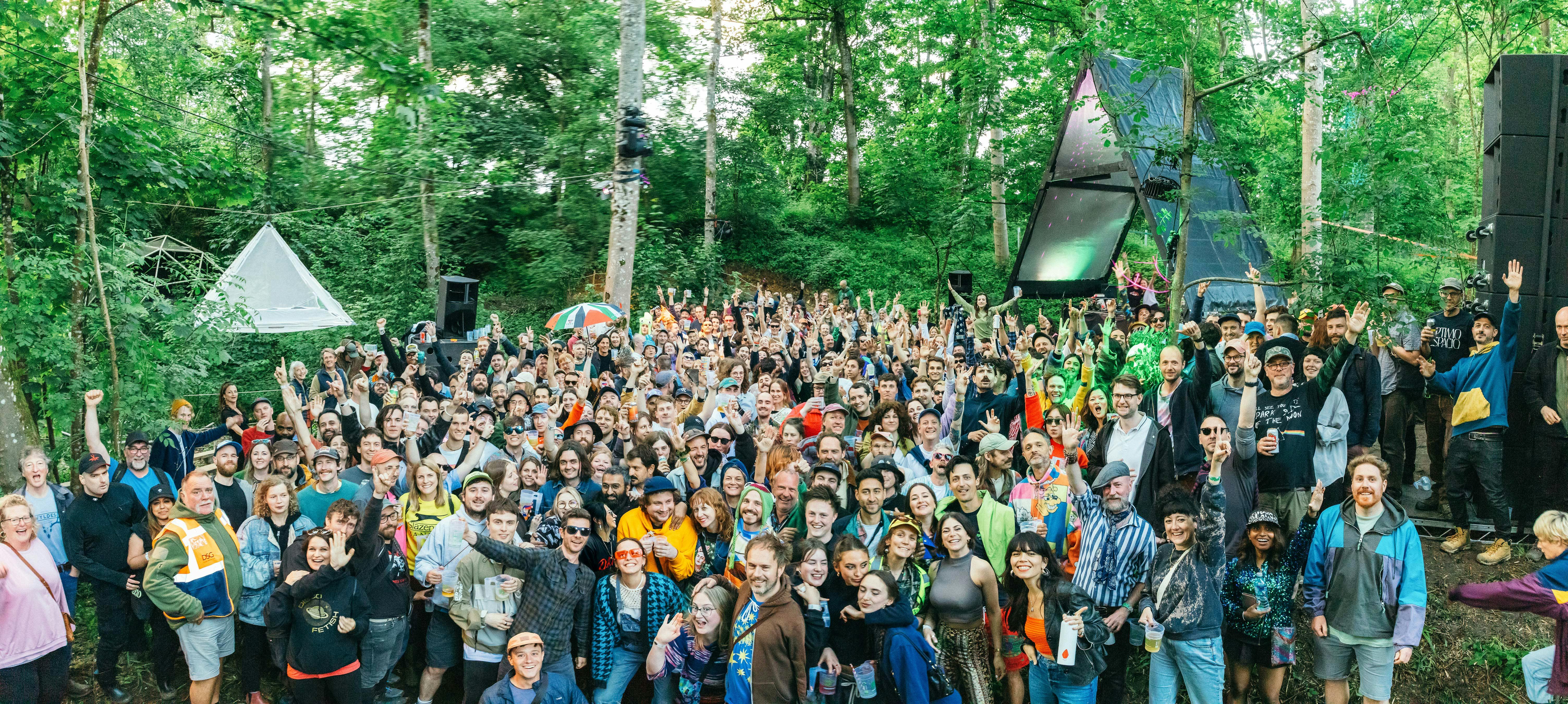
“We’re always thinking about ways to bring that energy, that oneness, the ecstatic feeling of the first time we danced outdoors in woodlands and open fields and enjoyed those sacred connections.”
Somewhere in the middle of a nameless woodland, elsewhere in Wiltshire, it’s the beginning of June. The once very wet ground dries steadily under the gaze of the sunlight that the Watching Trees organisers feared may never come. How lovely the road ahead now looks for the 500 people who opted to tune in and drop out. A 24-hour sonic ramble through a dream world, where everyday life and its structures are forgotten, replaced by art, beauty and euphoric stirrings.
Watching Trees is one of life’s special occurrences, where everyone contributes what they can, for the love not the money, to make a good idea something great. This is an Optimo and Ransom Note production, together with a committed band of merry makers and creators.
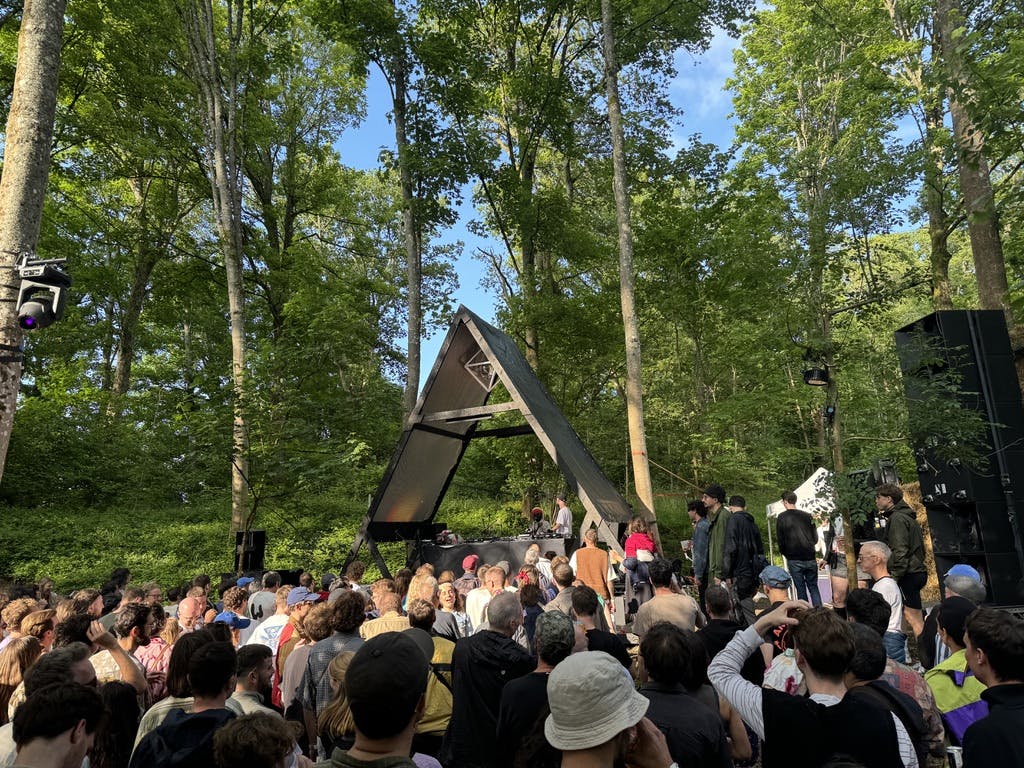
The festival’s first outing came in 2022, when Optimo’s agent Caroline Hayes (Spun Out Agency) approached Wil Troup (Ransom Note) with the idea of doing a party to mark the duo’s 25th Anniversary. This would be a continuation of various collaborations over the previous 15 or so years. A London party was quickly ruled out in favour of an out-of-town affair and with Optimo’s Jonnie Wilkes (JG Wilkes) and Keith McIvor (JD Twitch) fully onboard, together with designer Jess Lau (Tiny Beast), lighting/production designer Rob Jones (Bloom Installations) and a rich collection of contributors (Jim Angell of Sancho Panza, Kieran ‘The Overseer’ Alington, endless feeder, builder and all round energy Fin Curran and artist Jamie Tobin) it was full steam ahead towards a cosmic adventure in the wilds.
“I didn't think any of us realised just how much had to go into it,” says Caroline. “Afterwards we were scared off for a little while until we remembered how gratifying it was. It was probably one of the best things I've ever done. You put all the elements together, but you never know how it’s going to be. You can't imagine it, but people were saying how special it was. It had a very cosy, friendly, open vibe to it. You can't plan for that, but some how we created it.”
However, a spanner lurked just around the corner and firmly lodged itself in the works when the original Gloucestershire site was taken off the table. The search was on for a new location. “We looked at loads of different sites but none of them were quite right,” says Wil. “We put it down for quite a while, then one day I said to Jonnie ‘should we just stir the pot one last time and see what happens?”
“So many people were coming up to me saying ‘this is the best, most immersive sound I've ever heard.’ People who don’t have an interest in audio, with no idea what Funktion-One is or anything. It isn’t common for that to happen.”
This time they struck gold. Jonnie got in touch with a friend in Glasgow, which led to conversations about a potential new site. The following week they headed to a mystery location in North Wiltshire. There they found something so special, any notion of rational thought instantly evaporated.
“It felt like you're being taken into a little mystery world,” says Caroline. “It's just very beautiful countryside with loads of really tall trees but the pièce de résistance was this old quarry.”
“There was a flat thoroughfare and field that we could have used,” explains Jonnie. “It had infinitely better access for vehicles and would be a much easier workspace, but when we saw this little abandoned, overgrown quarry that you looked down into like a glade, we knew it had to be down in there."
“It’s just a magical, unique spot,” says Keith. “It was crazy to use it, but it would have been crazy not to.”
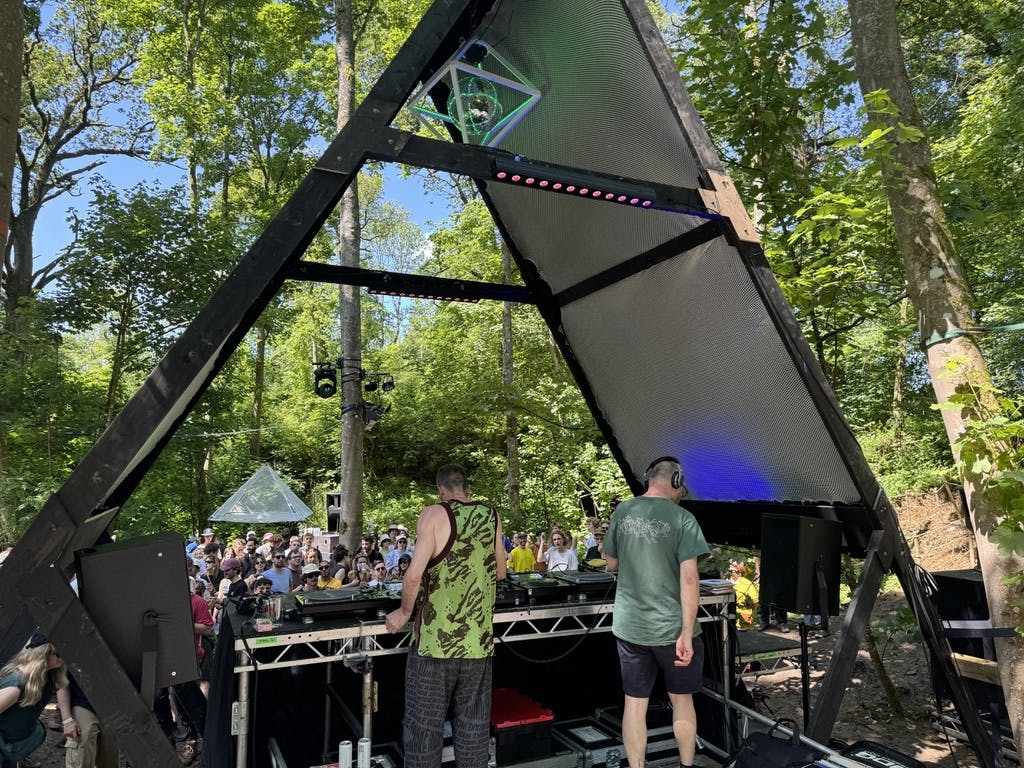
When Curt Gilmore (Sound Services Ltd) first visited the site in April, his thoughts were just as contrasting: “This is one of, if not, the most difficult sites I’ve ever been to. Count me in.” Understanding the challenge at hand, Curt brought in James Marsh as a tried and trusted support in tricky situations.
It would take an extraordinary effort to turn this enchanting wilderness into the new Watching Trees location, a feat made all the more remarkable by this year’s 24-hour format. “It’s one of the most difficult places you could hope to use as a dance floor,” says Rob. "It took plenty of imagination and determination to make it work. The position and orientation of the stage was based on the layout of the trees and the flow of people into the woodland, specifically the views from the walk around the embankment above and into the quarry.”
“As soon as Rob and I saw it, we could imagine it,” says Jonnie. “There were two trees there and we both immediately thought the stage has got to go between them. You can look from the top of the quarry down into that space. We imagined that lit at night and with the sun shining and we thought it would be great for containing the sound, but that's not how the science works at all. As soon as Curt came along, he was like, ‘oh, okay, I can see why you chose this space but to make great sound in there it’s actually more challenging.'"
Concerns about the potential for offsite noise disruption led to Sound Services visiting two weeks before the event to test if travelling low frequencies would be a problem in the nearest village. “We were terrified that we’d found this incredible place but would then get so many complaints that we wouldn’t be able to do it again,” says Caroline.
It transpired that there was an issue, which led to Curt (with support from Funktion-One) redesigning the system with a cardioid bass mono stack comprising six F121 enclosures in a column; with the centre two reversed for cardioid rear rejection. This would have the dual benefit of vastly reducing low frequencies travelling behind the stack towards the village while pushing more low-end energy onto the dancefloor. The four point Evolution X configuration would also be beneficial to the cause. It would contain the mid/high portion of the spectrum by enveloping the dancefloor with even sound while keeping the level from each speaker lower than in a more conventional two-point arrangement.
There would also be the added bonus of the visual spectacle, says Jonnie: “He came up with such a clever design and we worked on it visually as well. We wanted to consider the way that the system looked and appeared to people within that very natural space, overgrown with lots of foliage. A lot of engineers wouldn't be interested in that. They’d just be like ‘I'm putting my system here and that's how it's going to be.’ That's how we got to this monolith of bass up on the highest point in the quarry.”
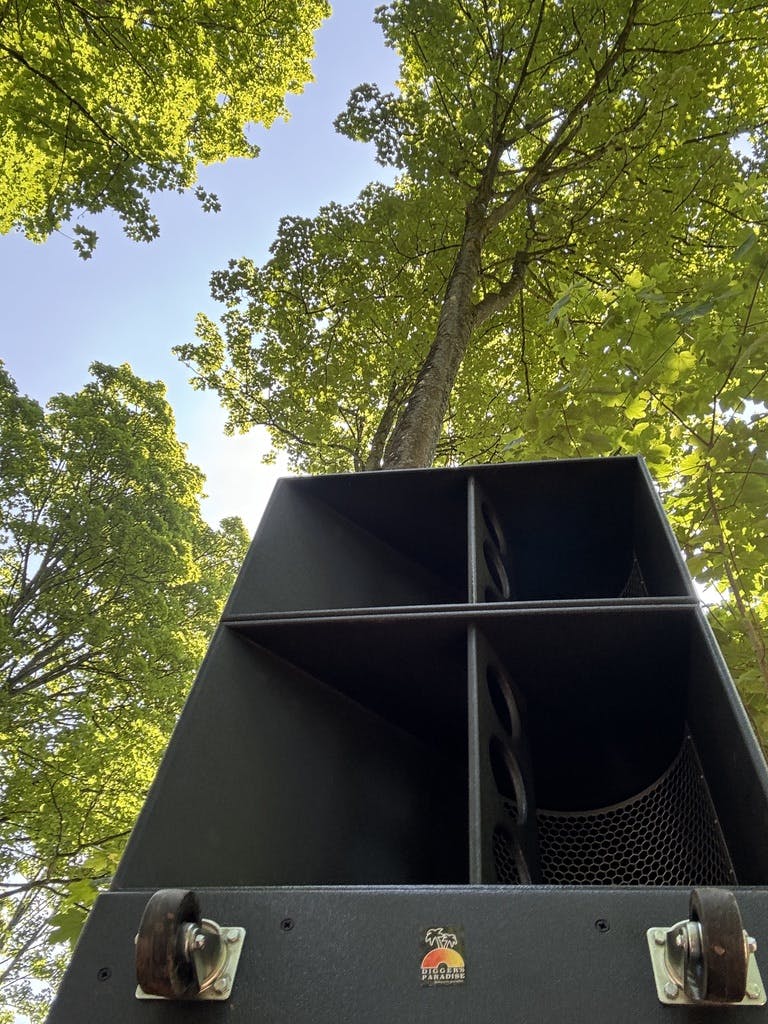
The new 24-hour format emerged from a combination of time constraints and the appetite for experimentation that seems to be central to the Watching Trees genome. “We didn't know how it was going to be received,” said Jess. “We hadn't really seen anything similar. We were thinking of different ways to make it accessible for people to come for 24 hours. We put on coaches from London and Bristol for people catching flights and we had our rent a tent scheme, where you could buy a tent and then it would be donated to charity afterwards. It all worked out really well in the end.”
There would be two stages; ‘Isle of Everywhere’ for the main programme and a second stage for spoken word and ambient music. The reason 500 people snapped up the tickets in little over a week when they went on sale in February has a lot to do with the fact the music is programmed by Optimo. For more than a quarter of a century they have held cult status for their DJing, production work, their ability to throw very good parties and their general view of life.
Keith took the reins: “We decided to do this 24-hour event, so that very much fed into the programme. I just tried to imagine how it would work over the course of the 24 hours and booked artists that I thought were interesting and would fit. We didn't want to piss off the local community by having thumping music throughout the night, so there was an arc to the 24 hours which started gently and then got more intense. Then at a certain point in the night, about four in the morning, it just broke into an ambient space until about 11am.”
On the Wednesday beforehand, with two days to go, the problem-solving brain matter was starting to run out of steam. As the rain continued to pour and the mud got more problematic, the bedraggled team looked out the cancellation insurance; just in case.
“At times it did feel like everything was against us,” says Rob. “The number of challenges that could have easily caused it to not happen at all."
Reinforcements would come from a crew of willing helpers from all over, including the land owners and a particularly kind local farmer. “Tony was amazing. He ended up pulling us out of the mud and lending us his Land Rover for the whole week,” says Wil. “On the Wednesday night him and his brother came across and everyone was pretty stressed. He just said, ‘think about it this way, how often do you get a chance to spend a week in a field with such beautiful people and hang out together?’ That is, I guess, the fundamentals of it. It's just doing something nice with beautiful people.”
It was Tony’s Land Rover that was used to ferry Sound Services’ sizeable inventory of audio kit from their van, turning a two-hour load-in into most of Thursday. Once onsite, Curt’s attention to detail was an immediate presence.
Jonnie says: “He was using a theodolite and lasers to line up the horns on the four speaker stacks, which were very strategically placed to the millimetre in a rough, undulating quarry situation, with each stack having bespoke legs on plinths to the exact level. Then Curt would be like, ‘it's not level, it needs to come down,’ because unless the measurements are right, to the millimetre, the whole thing falls apart and he was not prepared to let that happen.”

With the speaker stacks perfectly aligned and the sun breaking through the clouds, the emotional fog of the preceding days started to lift. Watching Trees lived and breathed with colour, beauty and life for a full turn of the clock. The sound was always going to matter for this event and for the people behind it. In Curt, they found someone who it matters to most. He stayed with the system for the whole event, tweaking and tuning it for each artist.
Keith says: “So many people were coming up to me saying ‘this is the best, most immersive sound I've ever heard.’ People who don’t have an interest in audio, with no idea what Funktion-One is or anything. It isn’t common for that to happen, but it was a conversation that came up over and over again. They were saying ‘this sounds incredible’ and it absolutely did. It was next level."
“Like, it sounded really good,” says Jonnie. “This is definitely the way that Funktion-One stuff is supposed to sound.”
“I was there during the initial sound test when we didn't have the cardioid set up,” says Rob. “Curt was driving around the local area trying to do the sound readings and realising that we had an issue. The difference then with this cardioid system and being around the back of the speakers, I just couldn't believe it. I’ve never experienced anything like that before. Once I came in front I was overwhelmed by this unbelievable change in sound. It was just so wonderful. I think it blew everyone away. It blew me away.”
“It was amazing on the dancefloor,” says Wil. “It never sounded like the system was ever straining. It could have been louder, but it didn't need to be. It was just perfect. Honestly, some of the most amazing sound I've ever heard anywhere… plus it looked amazing too with the quads and the mad bass stack.”
He continues: “One of the highlights of the whole festival was skulking around in a graveyard down in the local village whispering in pitch black with sound monitoring equipment. Caroline and I were looking at it thinking ‘it looks like there might be an issue at 50Hz’ and Curt would know it was 50Hz just by listening. His ears are pretty crazy things.”
Caroline says: “For him then to be texting James saying, bring this level down at a specific frequency, then the music would disappear. It was incredible.”

Looking at Optimo’s schedule throughout the summer, with weekends full of gigs at clubs and festivals around the world, you’d be forgiven for wondering why they’d want to add their own time and energy draining event to the calendar.
“I think it's really important for us to make a contribution to this thing that's been our lives for a long, long time,” says Jonnie. “And we want that contribution to be pure and honest and really the best that we can possibly give.”
“Maybe it sounds a bit hippy dippy, but if you put that energy out there, it rewards you back,” says Keith. “We've been rewarded in that we have exactly the audience we would want to have at this, there's nothing but love. It's hedonistic, but also sensible. People are looking after each other. You put that energy out there and it comes back by attracting the people that you would want to be there.”
“When you approach things without a financial goal, other people seem to be able to pick up on it and want to help you achieve it as well,” says Rob. “If they thought you were doing it to make money, I don't think they'd be quite as keen to just give up all their time and energy. That also fosters this really wonderful feeling on site and around the festival and I think people attending can feel that and appreciate the love, care, and energy that's been put into it.”
Watching Trees will return in 2025. Watch this space.
